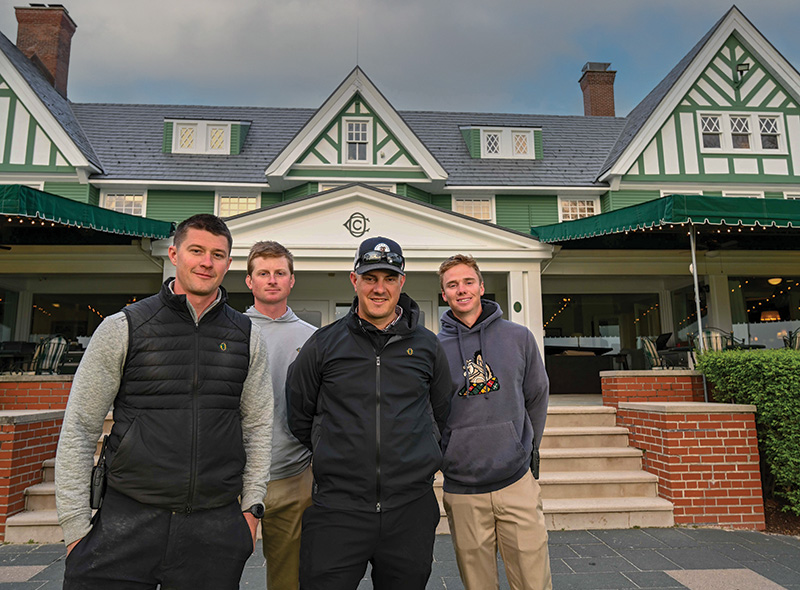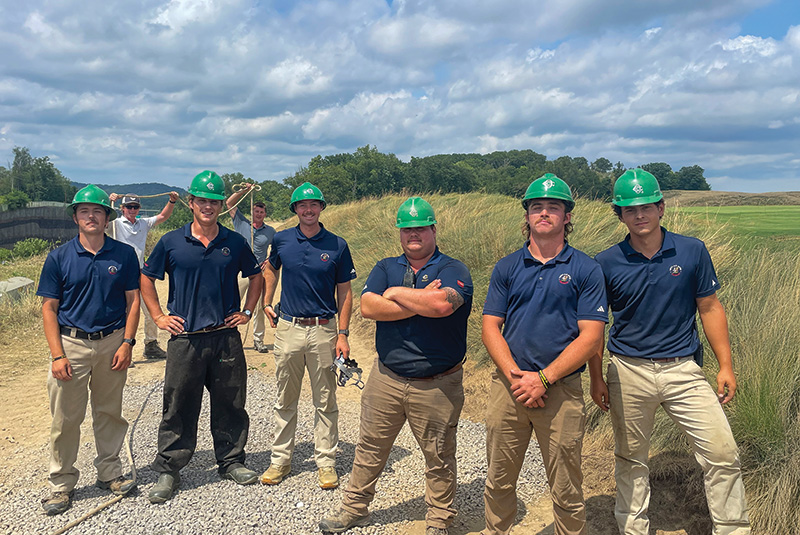
Mike McCormick is the GCSAA Class A superintendent at Oakmont Country Club in Oakmont, Pa., which is hosting the 125th U.S. Open June 9-15. Photos by Fred Vuich
Mike McCormick has a history with Oakmont Country Club.
He worked his way up there and even got engaged there. This month, McCormick will accomplish something new. The 10th U.S. Open at Oakmont CC in Oakmont, Pa., will be No. 1 for him as grounds superintendent. He and his team have been preparing for years what Oakmont CC has in store by hosting the 125th U.S. Open June 9-15.
Nowhere else has hosted this many U.S. Opens. Yet for even its fabled history, some things may look different there since the last U.S. Open at Oakmont in 2016. The club underwent a massive restoration. Staff has come and gone, but a pillar of the maintenance department, its culture, continues to be a driving force. McCormick is among those who departed. He left after that U.S. Open nine years ago to be a first-time superintendent in another state, but his heart remained at Oakmont. There are reasons. Like in 2017, when he made the six-hour drive from the job he had left Oakmont for in New York to return for a day to propose on the third green at Oakmont to Jamie, the woman he met there nine years ago who won his heart.
You see, his heart never truly left there. And, three years ago, McCormick accepted the job of a lifetime when he returned to oversee Oakmont.
Living the dream? You betcha.
“Oakmont was always No. 1 on my list, the dream, if I could pick any place on the planet to be a superintendent,” McCormick says. This month, an enormous viewership from near and far will be watching to see what he and his team have done with the place.

Leading the maintenance charge, from left, Max Claassen, Grant Cushman, Mike McCormick and Justin Kysely.
The road to Oakmont
The ascent of Tiger Woods touched many young hopefuls. McCormick was among them.
“When he won the 1997 Masters, I really got into golf,” says McCormick, now 36, a native of Sudbury, Mass. His place in golf evolved at Stow Acres Country Club in Stow, Mass. Eventually, McCormick would prove to be a player in maintenance. In younger days, he began doing ground-floor stuff. He also observed.
“As I got older, I would watch the maintenance team on the golf course. I thought what they did was pretty cool,” McCormick says.
Then-superintendent Erick Koskinen served as a figure worth emulating. The culture that Koskinen established attracted McCormick, a GCSAA Class A superintendent and 12-year association member. “He fostered a culture, that buy-in to what we were doing. Great environment,” he says. “I identified that this is what I wanted to do.” Koskinen encouraged McCormick to attend college. He did so, first at the University of Massachusetts-Amherst Stockbridge School of Agriculture and later at UMass-Amherst. McCormick intended to do an encore at Stow Acres CC as a summer intern. Instead — with Koskinen’s blessing — he interned at The International Golf Club in Bolton, Mass., to work for industry legend Dick Bator. It was one of those inflection points in McCormick’s life and career.
Bator had a track record at famed places — Oak Hill Country Club in Rochester, N.Y.; Pine Valley Golf Club in Pine Valley, N.J.; and Merion Golf Club in Ardmore, Pa. “As a 19-year-old, he lit a fire under my rear, inspired me, encouraged me to work at the highest level,” McCormick says.

A look at Oakmont CC’s iconic Church Pews bunkers.
His effort was noticed. “He’s a different sort of cat,” Bator says. “Nonstop work ethic. Even the family that started Oakmont (the Fownes family), would be proud of what he’s doing.”
McCormick went on to intern for another of his mentors, Jeff Corcoran, then at iconic Oak Hill Country Club. Corcoran later recommended that McCormick should intern at Oakmont, which he did, including in 2010 when the club hosted the U.S. Women’s Open. McCormick became smitten with the surroundings. “From the moment I stepped onto this property, I realized it’s just a special place,” McCormick says. “I fell in love with the standards that are expected.”
McCormick stayed at Oakmont from 2011 to 2016. He worked his way up the ranks, from assistant in training to spray tech and then assistant before the 2016 U.S. Open. That year, McCormick was offered, and accepted, his first superintendent position after the U.S. Open. The Apawamis Club in Rye, N.Y., was the landing spot. “Great club, ton of history, perfect situation, perfect first (superintendent) job,” says McCormick.
It wouldn’t be his last job as a superintendent. Dave Delsandro, another McCormick mentor, exited Oakmont in 2022. Reenter McCormick, who accepted the reins in November of that year. His past with the club that was established in 1903 prepared him for his future there. A GCSAA Class A superintendent and 23-year association member now at Agronomic Advisors, Delsandro says, “I’m so proud to watch him operate. He came to us as a young intern, and we watched him develop. He was running around like crazy, couldn’t do enough. He has an insatiable appetite for knowledge; live it, eat it, can’t get enough of it. You get one of those guys every 10, 15 years if you’re lucky.”
In his comeback, McCormick was ready to get after it. “No. 1, coming back into this role, I knew what the expectations were, what I was getting into from a conditioning and agronomic perspective. Oakmont is legendary for continuing to raise the bar from an agronomic, conditioning and playability perspective throughout its entire history,” McCormick says. “As exciting as it was to come back, there’s a lot of pressure that goes with that. You can’t just come here and rinse and repeat and produce the same conditions as prior. You have to find ways to get better to produce a better product.”
He couldn’t do it by himself, says McCormick. “My assistants are the eyes and ears,” he says, “and our team (which includes those such as Stevie Buynak, in his 48th season) is on the field all day. There’s no standing around. They grind. Their attitudes are off the charts.”

Quite a view of the No. 9 green at Oakmont CC. Photos by Max Claassen
Restoring a classic
Justin Kysely didn’t know it at the time, but his history with Christmas trees prepared him for this.
Kysely is an Oakmont assistant who has participated in the largest restoration in Oakmont history. The Wisconsin native’s family previously owned Fraser Traditions, which was a Christmas tree farm. That led to him helping plant trees. Later, he also hand-picked cones, thousands of them.
“It helped me build a great work ethic. That’s important to how I am now at work,” says Kysely, a five-year GCSAA member. Undoubtedly, he put his work history and schooling to his advantage when Oakmont embarked on the architect Gil Hanse-led design restoration in March 2023 and was completed in 18 months.
Restoration highlights include 24,000 square feet of green expansion course wide. The No. 3 green is the largest expansion, at 2,500 square feet. Bunkers were redone. They’d deteriorated from a performance standpoint and how they drained, McCormick says, and contained a large amount of contamination and had steep bunker faces with erosion problems. “Gil came in and realized with Oakmont putting greens that were famous had changed quite a bit from what they were originally,” McCormick says. “Topdressing, aerification procedures and bunker sand splash … all the perimeters of the greens had elevated 6 inches to 3 feet in some scenarios. He suggested if we’re going to rebuild the bunkers, we should reestablish the perimeters of the greens to their original elevation, which will inherently allow us to also increase the size of the greens around the edges to their original footprint, and that would provide a lot of new hole locations around the edges of the green that didn’t exist in 2016.”
A high point for McCormick is membership and how it reacted to the restoration. “We stayed open in 2023, the whole year. We never closed the golf course,” he says. “We shut down the front nine from March to Memorial Day. Did all front-nine greens. We opened all 18 holes between Memorial Day and Labor Day. We worked on all fairway bunkers, put in 250 yards of new championship tees. After Labor Day, we closed down the back nine and did all the work to the back-nine greens. So, for that whole year in 2023, members had at least nine holes to play and could play it twice.”
Also, a new Toro two-wire irrigation system was installed throughout the entire property. Three pump stations were rebuilt. In addition to the added 24,000 square feet of putting surface areas, there are about 2 acres more of fairway area and teeing areas were increased by almost 75%.
“The end result was a product that was the closest it’s ever been to the original Fownes design and, on top of that, we added yardage to ensure that the Fownes features, particularly bunkers, were in play for the best players in the world,” McCormick says.
He adds, “It was unbelievable to be a part of the most historic project that the club has ever done — a highlight of my career, the team’s career, and we ensured the membership still had access to the golf course during it (the newly restored 18-hole course reopened April 2024). We sent out video updates, writings, to membership. The membership was out there as we performed the project, playing on fairways with bulldozers and excavators on each side of the fairways where we were building bunkers, so they got to see the project executed in real time, so that was the coolest thing about it.”
McCormick always credits his team, including his assistant superintendents, for making the operation hum.

This is the “Oakmont Swamper Crew” — team members who welcome the title of grinders.
Culture club
Culture travels at Oakmont. In one instance, it stretched 5.8 miles.
When Fox Chapel Golf Club in Pittsburgh needed a helping hand, Oakmont CC responded. A relatively short distance from Fox Chapel GC, Oakmont’s maintenance team totaling more than a dozen piled into two pickup trucks with rotary mowers to aid superintendent Devin Rice. He was hosting the U.S. Senior Women’s Open last August. More than 2 inches of rain fell two days before the championship started. A former assistant for seven years at Oakmont, Rice called Oakmont maintenance to see if they could offer volunteers to participate in cleanup, partly due to the Tuesday rain that was preceded by over another 3 inches the previous weekend.
Thanks to Oakmont Director of Agronomy Max Claassen, Rice got his wish. “We had an opportunity to give him enough volunteers to get everything he wanted to get done. I remember some of the guys leaving Oakmont at 5:30 (p.m.) and asking to head over with me, and it ended up being 15 that raced to go over without hesitation,” says Claassen, a two-year GCSAA member. “We went over there, and they offered us carts. We said, ‘No, we’d rather head off on foot.’ We were pushing mowers, taking care of our brothers. It was a long day, a day that epitomized what it is like to be a member of the Oakmont grounds crew and the culture we possess.”
Obviously, Rice spent time participating in Oakmont’s culture, which had been in the making years before under the guidance of previous grounds superintendent Delsandro and now McCormick. “For me, what they did that day speaks to their club, the atmosphere that Oakmont displays, people that would take their shirt off their backs for you,” Rice says. “Culture is the No. 1 thing at that club. It’s a standard. There’s an accountability that everyone holds everybody to. It’s self-sustaining, built upon a strong foundation.”
McCormick gets it. Culture at the club has been in evolution since he first was at Oakmont 15 years ago. It didn’t happen overnight.
“I remember you’d post an ad for interns, get 30 to 40 responses. We had to evaluate the culture, people we bring in. That’s changed substantially,” he says. “We actively recruit and drive to every turf school within a six-hour range of Pittsburgh. We fly to some places, do Zoom or Teams calls with turf schools. We talk about a culture, work experience they’re going to have and more importantly the learning experience they’re going to have at Oakmont.”

The 14th at Oakmont CC. Photos by Fred Vuich
Growing a culture
“What we’ve really built is a curriculum at Oakmont where people are learning in the field and off the golf course as well,” McCormick says. “We have a few different incentive programs we use every year — Intern of the Year, Agronomist of the Year, Big Brother-Little Brother of the Year.
“Every intern that comes in here has to take notes that are evaluated. We bring eight to 10 guest speakers — entomologists, pathologists, top in their fields, expose interns to the best in the industry. They learn how to grind reels, but they also learn how to build a résumé. On the final exam, all write grounds committee reports, do mock board reports and have a final presentation to a mock green committee comprised of Oakmont members. Ultimately, what it does is help guys learn on and off the course, an immersive experience, really getting something out of it more than just spinning their tires and doing the same thing over and over on the course.”
Oakmont also features its Big Brother-Little Brother program. A new intern is paired with a more tenured team member, who’s responsible for meeting the intern and helping them move into their apartment, go out to dinner first night, being responsible for teaching the little brother how to do anything from hooking up a three-point on a tractor to calibrating a sprayer.
“It builds a competitive environment, but everyone relies on others amongst their team to succeed, which creates a brotherhood, and that has created and stimulated an unbelievable culture,” McCormick says. “It’s all about their willingness to learn and then when they get here the culture kind of sustains itself where the guys have been on our team a few years, they know what the standard is, they pass it down to the younger guys. They embrace it, and it’s just an unbelievable culture at this point, and that is ultimately why we are able to produce the conditions on the golf course that we do.”

Fine fescue ditch detail by the Oakmont crew.
Show time
Assistant Grant Cushman received a partial college scholarship in music. He likes what Oakmont has orchestrated for the world’s top golfers this month. “As long as we’re dry, I think we’re in the driver’s seat,” says Cushman.
USGA Senior Director of Championship Agronomy Darin Bevard never is concerned about McCormick keeping his eye on the ball. “He’s very organized, focused on what needs to be done,” says Bevard, who also referred to sod laid last winter. “You know it’s going to be good, and you don’t have to go back and check on it,” says Bevard, noting this will be what he calls a traditional U.S. Open golf course with high rough (4 to 5 inches depending on the hole, plus there’ll be no graduated rough), narrow fairways and fast and firm greens.
McCormick chimed in that there’ll be one more Church Pews Bunker, raising the total to 13. Throughout the years, Oakmont removed thousands of trees, opening vistas that create opportunities to view more holes on a true parkland course more recognizable than ever. The one interior tree that remains is the American elm by the No. 3 tee.
Oakmont’s place among legendary facilities will expand. Oakmont, which has held 17 USGA championships, announced the U.S. Open will return in 2033, 2042 and 2049. McCormick is ecstatic to be along for the ride. “The Fownes wanted championships to be played at Oakmont into perpetuity,” McCormick says. “This place is majestic. To me, it’s the best place in the world.”
Howard Richman (hrichman@gcsaa.org) is GCM’s associate editor.